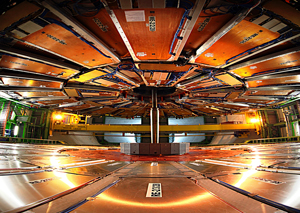Dec. 6, 2013 Research Highlight Physics / Astronomy
Quarks and gluons go with the flow
Calculations suggest that smashing protons into ions of lead creates a quark–gluon plasma that behaves like a liquid
 Figure 1: Inside the Compact Muon Solenoid (CMS) detector at the Large Hadron Collider. Photograph courtesy of Michael Hoch © 2013 CERN
Figure 1: Inside the Compact Muon Solenoid (CMS) detector at the Large Hadron Collider. Photograph courtesy of Michael Hoch © 2013 CERN
The Large Hadron Collider (LHC) at CERN (European Organization for Nuclear Research) in Switzerland is best known for its discovery of the Higgs boson, formed during collisions between bunches of protons travelling close to the speed of light. However, it has also been smashing protons into ions of lead to generate clouds of quarks and gluons—the fundamental particles inside the protons and neutrons of the atomic nucleus.
Experiments at the LHC have recently shown that this quark–gluon plasma is more liquid than physicists had expected. Adam Bzdak from the RIKEN BNL Research Center at Brookhaven National Laboratory in the United States and colleague Vladimir Skokov of Western Michigan University now offer an explanation for the effect1.
When two lead ions collide, the quark–gluon plasma they create flows like a liquid. This hydrodynamic flow carries other particles created in the collision, like boats drifting along a fast-flowing river.
Swapping one of the colliding ions for a proton should have made this hot soup behave less like a liquid because there would be fewer particles involved. Therefore, it came as a surprise when scientists at the LHC found that ejecta from these collisions were also carried along on a wave of plasma.
Bzdak and Skokov calculated what should have happened to the pions, protons and kaons generated in the collisions had the quarks and gluons acted independently, without hydrodynamic interactions. They then compared their results from this ‘wounded nucleon’ model with the LHC’s data for the collisions. They found that pions—the lightest particles—behaved very nearly as forecast by the model, whereas the heavier kaons and protons had more momentum than predicted. The more massive particles would receive a greater momentum boost from hydrodynamic effects, says Bzdak. “It’s an indication of hydrodynamics.”
Bzdak and Skokov’s calculations could help to refine scientists’ understanding of the quark–gluon plasma that filled the Universe during its first moments. Pinning down how quarks and gluons interact at different energies would also help to refine the quantum theories that describe their behavior.
Bzdak notes that there is an alternative explanation for the LHC’s observations, called the color glass condensate model. The model predicts that at very high energies, protons become saturated with a seething mass of extra gluons, which explains the extra momentum gained by more massive particles spraying from the collision. The next challenge for physicists, says Bzdak, is to test other experimental predictions of the two models to work out which of them offers the best description of the quark–gluon plasma.
References
- 1. Bzdak, A. & Skokov, V. Average transverse momentum of hadrons in proton–nucleus collisions in the wounded nucleon model. Physics Letters B 726, 408–411 (2013). doi: 10.1016/j.physletb.2013.08.021
